
This paper was written as part of the 2005 Alaska Ocean Sciences Bowl high school competition. The conclusions in this report are solely those of the student authors.
Global Warming Effects on Fishing in Unalaska
Authors
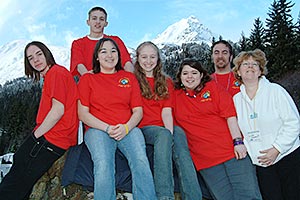
Abstract
With the onset of global warming many signals are beginning to appear in marine ecosystems. Rather than looking for a way to "cure" global warming, our team decided to find out how to measure the changes in climate so that Alaskans that are using waterways will be best able to adapt. We interviewed and surveyed 100 Unalaska "stakeholders" to determine what oceanographic instrumentation would be most help to monitor changing climate conditions. Of the 100 surveys retrieved from commercial fishermen, local/subsistence fishermen and researchers,'more accurate forecasts' was the predominant choice. The results of these surveys will be presented to the work group of the Alaska Ocean Observing System to help dedicate resources towards this effort in the years to come.
Introduction
General affects of global warming
With all of media, it seems to be a common understanding that the world is heating up. This is caused by global warming, but how exactly does that affect us? "Global warming will be the greatest environmental challenge in the 21 st century," said former Vice President, Albert Gore. Since the 1960s, annual average temperatures have warmed up to 1.8° F (1.0° C) per decade, with winter warming as high as 3° F (2° C) per decade (http://www.climatehotmap.org/events/136.html, Brass, 2002, Kerr, 2002, Walther et al., 2002). A warmer ambient water temperature could cause species range extensions that could cause increase competition for resources with native species or predation on those species. Warmer waters in winter may be associated with reduced size and survival in some fish species (Norcross et al., 2001). Warmer temperatures could also affect the amount of dissolved oxygen in the water, which may cause physiological stress to organisms that are already stressed. Warmer water and shorter winters could cause a fixed stratification in the water column not allowing for nutrient upwelling and hence decreasing the productivity of the ocean food web.
In a study of 67 glaciers done between the 1950s and 1990s, the glaciers thinned by an average of about 1.6 feet per year (Arendt et al. 2002). In Alaska, tourists come from all over the world to see our beautiful cascading glaciers, but in the shadow of global warming, they may disappear. Decrease in the amount of sea ice may also affect Alaskans and tourists to Alaska. The Arctic Research Commission indicated that ice extent will decrease by roughly 30% and ice volume by roughly 40% by the year 2050 (Brass, 2002, Kerr, 2002). Less ice will become problematic for those organisms that depend on the ice cover like: under-ice diatoms, seals, polar bears, and walrus (Kerr, 2002), not to mention significantly increasing sea level height that may cause flooding, erosion, and increased sediment runoff.
In the atmosphere, as the Arctic boundary layer becomes warmer and wetter, cloudiness will increase and storm seasons will extend with an earlier onset and a later decline. This moisture will likely cause an increase in freezing mist and drizzle as well as an increase in the stratification of the upper ocean (Brass, 2002). Thawing of the permafrost layer will cause erosion damage as well as increase flooding (Brass, 2002). Thawing permafrost in the Arctic has damaged houses, roads, airports and pipelines, and caused landscape erosion, slope instability, and landslides. (http://www.ciel.org/Climate/Climate_Arctic.html).
The timing and changes in composition of river runoff will affect surface sediment load, reducing the summer runoff and increasing the proportion of winter runoff (Brass, 2002). Increased sediment loads due to an enhanced hydrological cycle could increase coastal erosion, impact mixing of fresh and saline water, reduce the optical transparency, and alter seawater chemistry.
Recent changes in climate are affecting a broad range of organisms with diverse geographical distributions (Walther et al., 2002). Global warming may cause temporal problems for species of wildlife. With many organisms depending on temporal signals to instigate certain activities, a change in timing of seasons could prove problematic. Migrating birds, seasonal reproductive cues, and daily foraging activities may be confused or complicated by a shortening or lengthening of the seasons.
Yet another symptom of global warming is called ice-albedo feedback. It is caused when rising temperatures produce shorter winters, less extensive snow and ice cover and an increased absorption of solar radiation due to decreased albedo (Brass, 2002, Moritz et al., 2002). With the onset of ice-albedo feedback, global warming may begin occurring at a faster rate, increase the intensity and affect of change.
Over the next 10 to 50 years, the effects of global warming should be more pronounced, first through atmospheric and near-surface processes and later through geomorphologic and hydrological responses to permafrost melting (Brass, 2002). Signs of warning are everywhere and these changes are bound to effect the entire planet (Sturm et al. 2003).
Global warming effects on fishing
The response of marine resources to global warming is difficult to predict. It is likely that a northward migration of species will result from direct (temperature) and indirect (ecological disruption) factors associated with global warming. The Bering Sea, for one, is currently experiencing a northward biogeographical shift in response to changing temperature and atmospheric forcing (Overland and Stabeno, 2004).
The direct effects of global warming deal with a rise in the ambient temperature of the water, which may cause stress on species that are at or near their physiological limit. With the onset of general warming trends, most organisms have differing physiological tolerances of temperature and precipitation (Walther et al., 2002). Certain species will be unable to adapt to a warmer temperature and will be forced to stay and die, or migrate to other areas with more favorable conditions. We may already be seeing examples of this as several warm water species have begun to migrate well beyond their geographical range along the Pacific coast. In October 2004, Humbolt squid were observed for the first time in Alaskan waters. According to James Cosgrove, the manager of natural history at the Royal British Columbia Museum, the farthest north this species had been reported prior to 2004 was near San Francisco. These squid have also been spotted near Yakutat and Kodiak Island. Other species that are not normally seen in Sitka Sound were observed in October including: the first thresher shark caught in 14 years, two great white sharks, the carcasses of a hard-shell turtle and a jack mackerel. All of these species are showing up further north than their usual habitat, which researchers are attributing to an increase in ocean temperature (http://diver.net/, 2004).
In the Bering Sea, in recent years, fishermen are having to go further and further north to catch species of fish including Walleye Pollock, Herring and Sablefish. Changes in fisheries dynamics may have monumental implications for communities that exist primarily to work those fisheries. Among the Alaska Native population, 50% of the calories consumed come from Alaska wildlife (Brass, 2002). Changes in locally available subsistence food could affect the livelihood of some of the oldest civilizations in the nation (Overland and Stabeno, 2004).
Importance of Fishing in Unalaska
The city of Unalaska, Alaska is located 800 air miles southwest of Anchorage and 1,140 miles northwest of Seattle. Unalaska is recognized both as a regional transportation hub and an international trade center. It has been recognized as the #1 port in the nation since 1992 for seafood volume and value (exception in value ranked #2 in 2000, Table 1). In 2002, commercial fishermen brought 908.1 million pounds of fish and shellfish to the port of Dutch Harbor-Unalaska, Alaska—an increase of 73.6 million pounds over 2001 landings—surpassing the 32-year volume record of 848.2 million pounds held by the port in Los Angeles, California.
Approximately 90% of the work force is economically dependent on the fishing industry. Chris Hladick, the City Manager for Unalaska said, "80% of Unalaska's work force is either directly or indirectly related to fishing." Commercial fishing and fish processing are the major economic components, and the fishing and port-related service sectors are well developed (Figure 1). Manufacturing is the key component of Unalaska's economy owing itself primarily to the production of seafood products. A vital segment of Unalaska's business sector is service, repair and maintenance to the domestic and foreign fishing fleets, plus service to on and offshore-based processors.
Unalaska represents just over 80% of the population of the Western Aleutians, and a large number of the major employers listed for the Western Aleutians are headquartered in Unalaska or do business in Unalaska. Certainly, Unalaska is a driving force in the economy of the Western Aleutians, and statistics for the region may parallel statistics for Unalaska to some degree. The top 5 employers in the Aleutians West census area are seafood processors (Table 2).
Fishing and fisheries support are the backbone of Unalaska's economy. According to the Unalaska City Manager Chris Hladick, "without fishing, Unalaska as it is, would cease to be." Some Alaska Natives and other subsistence hunters derive almost all of their livelihoods from fisheries. If key species migrate north due to increased temperatures, Unalaska will not survive. Sharon Svarny-Livingston of the Qawalangin Tribe of Unalaska said that "without fisheries, Unalaska would most likely turn back into a small native village."
Fisheries in recent years
In recent years, fishing in Unalaska has not experienced any significant changes, but on a decadal scale, fishing has changed significantly. Sharon Svarny-Livingston of the Qawalangin Tribe of Unalaska said that "we are seeing changes in some species (crab), but not others (salmon and pollock)." She talks of a time where one could go fishing for crab off of any dock with a simple hook and line. Scientists have generally accepted that fisheries in the Bering Sea have changed from a benthic existence (crab) to a pelagic existence (pollock).
Fisheries and global warming
The question is,'why has fishing changed?' Are the negative impacts that we are seeing associated with global warming? What changes can be made? To a large extent, no actions have been taken to minimize the effects of global warming because science cannot demonstrate "beyond a reasonable doubt" which factors are directly contributing to global warming. Is there a possibility that the changes that we are seeing are the result internal variability of the Arctic climate system? Moritz et al. (2002) suggest that both external forcing and internal dynamics contribute to some of the observed changes in the Arctic climate, both temporally and spatially.
A case of need
Clearly we need to be observing the oceans and monitoring changes as the direct and indirect implications of global warming affect our perspective communities. The overall goal of this project was to ask local and transient ocean "stakeholders" what oceanographic instrumentation'they' thought would be most helpful to "them" as the onset of global warming appears in the years to come. It was our intent to determine the local perspective on the best way to monitor global warming and to pass that information on to decision makers planning for the future of our oceans.
Methods
Surveys and interviews were performed in Unalaska/Dutch Harbor, Alaska from August to December, 2004. One hundred and fifty surveys were handed out to commercial fishermen, local/subsistence fishermen and local researchers. Because the Bering Sea red king crab commercial fleet is only in town for a couple of days, we sampled commercial fishermen just before the 2004 fishery. Team members were paired up with local Alaska Department of Fish and Game biologists to explain our project and to hand out the surveys. All other surveys were completed later by local community members. Of the 150 surveys handed out, 100 were retrieved, 65 from commercial fishermen, 25 from local/subsistence fishermen and 10 from research biologists.
The purpose of the survey was to extract information from Alaska's ocean stakeholders that might help environmental planners. The surveys asked the participant to rank order from one to five, the oceanographic instruments that they would like to see come online to help with marine forecasting (Figure 2).
Interviews were performed to gain insight into global warming issues as they relate to cultural, economic and logistical city issues. Interviews were recorded and statements used with the permission of the person being interviewed. The results of the surveys and interviews were presented to the community in order to gain further feedback.
Results
Of the 65 commercial fishermen surveyed, 82% said that 'more accurate forecasts' would be in their top five choices, with 'surface wind maps' coming in 2nd at 62% and 'forecasts updated faster' in 3rd at 55% (Table 3). Of the commercial fishermen surveyed, 30 said that 'more accurate forecasts' would be their 1st choice, 7 said it would be second and 3 said it would be 3rd (Table 4).
Of the 25 local/subsistence fishermen surveyed, 85% said that 'more accurate forecasts' and 'forecasts updated faster' would be in their top five choices, with 'surface wind maps' coming in just behind at 65% (Table 3). Of the local/subsistence fishermen surveyed, 9 said that 'more accurate forecasts' would be there 1st choice, 1 said that is would be second and 3 said it would be 3rd (Table 4).
Of the 10 research personnel surveyed, 60% said that 'extent of sea-ice melting' and 'biological productivity (primary productivity)' would be in their top five choices, followed closely by 7 other categories with 40% in the top 5 (Table 3). Of the researchers surveyed, 4 said that 'biological productivity (primary productivity)' would be their 1st choice and 2 said it would be 2nd (Table 4).
Of the 100 Unalaska stakeholders surveyed, 75% said that 'more accurate forecasts' would be in their top five choices, with 'surface wind maps' coming in 2nd at 60% and 'forecasts updated faster' in 3rd at 58% (Table 5). Of the 100 stakeholders surveyed, 44 said that 'more accurate forecasts' would be their 1st choice, 8 said it would be second and 6 said it would be 3rd (Table 5).
Discussion
Climate change in the Arctic may be described by spatial patterns associated with physical processes as a result of internal or external forcing. There is a great deal of overlap in the resulting identification of mechanisms and without clarification of cause and effect. We must invest our efforts in understanding the scale of change. Clearly, there is no perfect solution to global warming, the best that we can do is to attempt to mitigate its affect and to monitor changes as they occur. Overland and Stabeno (2004) suggest that we look at Bering Sea indicators over the next 5 years. Walther et al. (2002) suggest that projected warming for the decades to come will raise even more questions.
Based on the results of the surveys and the community interviews, it is apparent that fisheries managers and environmental organizations need to invest their efforts in getting 'more accurate forecasts' to Alaska's stakeholders. As the climate changes our best indication of that change will be based upon the accuracy of measuring that change. Without accurately measuring the climate, how can think to observe what it is doing?
The second area that Alaska's stakeholders listed as a top priority is observing 'surface wind maps.' Changes in temperature are related to alterations in oceanic circulation patterns that are affected by changes in the direction and speed of the winds that drive ocean currents and mix surface waters with deeper nutrient rich waters (http://www.pfel.noaa.gov/research/climatemarine/cmffish/cmffishery.html#FISHPOPUL). Winds also impact how, when and where fishermen and researchers can go. As circulation patterns change, so will fishing.
The third area listed as a top priority was having 'forecasts updated faster.' With an increase in the volatility of climate systems, having the latest information will prove essential for Alaskan stakeholders.
By gaining this local perspective, perhaps ecosystem planners will have an idea of what is important to the people using these resources. As global warming becomes more evident, Alaskan's want to know what is going on accurately, faster, and in reference to circulation patterns.
Recommendation/Conclusion
The Global Ocean Observing System (GOOS) is an international collaboration designed to improve forecasts and assessments of weather, climate, and ocean states for regional observing systems. OceanUS is a national office that was established to coordinate and develop the United States portion of this data collection as well as to implement the Integrated Ocean Observing System (IOOS). IOOS is a coordinated effort between national and international observations for the past, present and future states of the oceans. The Alaska Ocean Observing System (AOOS) is a regional node for the national network of observing systems. The mission of the AOOS is to improve our ability to rapidly detect change in marine ecosystems and living resources, and predict future changes and their consequences for the public good. The AOOS is currently developing a functional program for the near future as part of the national effort. The potential users of AOOS are: fishermen, subsistence harvesters, shippers, oil industry, resource managers and researchers.
Considering both the effects of global warming on the city of Unalaska and the involvement of local people with fisheries, we developed a project that may offer some insight into the needs of Alaska's stakeholders to the Alaska Ocean Observing System in early planning stages.
Based upon the results of our efforts, we suggest that Alaska Ocean Observing System invest both time and money in adapting technologies that will allow us to efficiently monitor the changes in Alaska's climate as the effect of global warming become more prevalent. Alaska's stakeholders have spoken and having 'more accurate forecasts,' 'surface wind maps,' and 'forecasts updated faster' tops the list. Efforts in these key areas may allow fishermen, marine transportation organizations, and researchers to be better able to understand the effects of global warming and the resulting effects seen in their perspective use of the ocean.
In the end, efforts to observe climate change may affect all of the coastal cities and villages in Alaska. Although the effects of global warming are just now being observed and quantified, being able to accurately determine changes in climate could affect the survival of countless individual and towns in Alaska. Unalaska, for one, would not exist without fisheries, and fisheries may not exist in Unalaska with the onset of global warming.
Tables and Figures
Table 1. Value and Volume of fishing in Unalaska (DOL 2000).
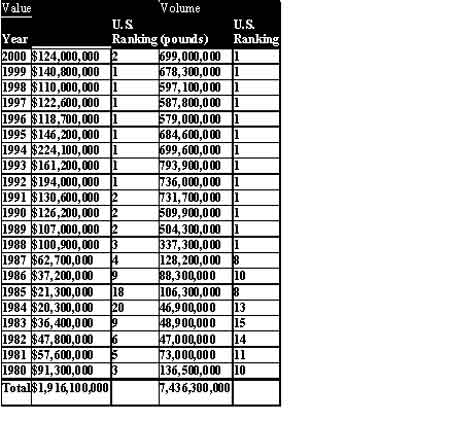
Table 2. Rank ordered employment in Aleutians West Census area
|
Employer Name |
Industry |
Four Qtr Total |
1 |
UNISEA INC |
Seafood processor |
833 |
2 |
WESTWARD SEAFOOD INC |
Seafood processor |
485 |
3 |
NN VICTOR PARTNERSHIP |
Seafood processor |
387 |
4 |
ROYAL ALEUTIAN SEAFOODS INC |
Seafood processor |
195 |
5 |
ALYESKA SEAFOODS INC |
Seafood processor |
182 |
6 |
N STAR TERMINAL AND STEVEDOR |
Other TCU 1/ |
151 |
7 |
YARDARM KNOT FISHERIES LLC |
Seafood processor |
147 |
8 |
CARGO SERVICES CO |
Other TCU 1/ |
133 |
9 |
BLUE WAVE SEAFOODS INC |
Seafood processor |
108 |
10 |
AK COMMERCIAL CO |
Retail Trade |
99 |
Table 3. Top 5 choices for commercial fishermen, local/subsistence fishermen and researchers
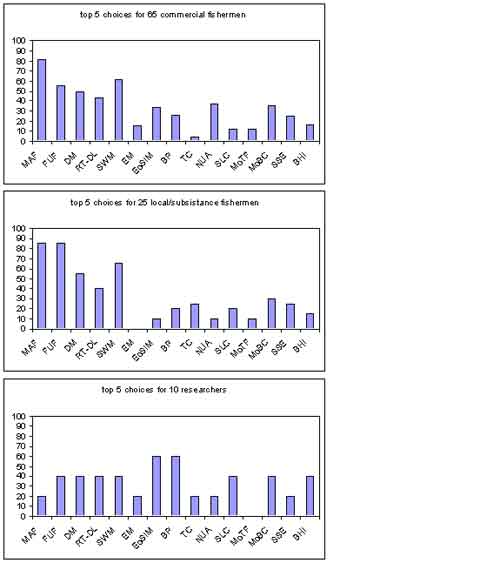
MAF–More Accurate Forecasts |
TC–Tertiary consumers (seabirds, whale, etc) |
FUF–Forecasts Updated Faster |
NUA–Nutrient Upwelling areas |
DM–Downloadable Maps |
SLC–Sea-level changes |
RTDL–RealTime Downloads |
MoTF–Maps of Through-Flows |
SWM–Surface Wind Maps |
MoBC–Maps of Boundary Currents |
EM–Eddy Maps |
SSE–Storm Surge Effects |
EoSI–Extent of Sea Ice Cover |
BHI–Benthic Habitat Information |
BP–Biological Productivity (primary productivity) |
Table 4. Percentages of first, second and third choices for commercial fishermen (55***), local/ subsistence fishermen (25) and researchers (10).
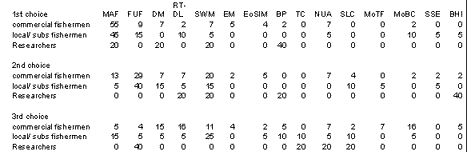
MAF–More Accurate Forecasts |
TC–Tertiary consumers (seabirds, whale, etc) |
FUF–Forecasts Updated Faster |
NUA–Nutrient Upwelling areas |
DM–Downloadable Maps |
SLC–Sea-level changes |
RTDL–RealTime Downloads |
MoTF–Maps of Through-Flows |
SWM–Surface Wind Maps |
MoBC–Maps of Boundary Currents |
EM–Eddy Maps |
SSE–Storm Surge Effects |
EoSI–Extent of Sea Ice Cover |
BHI–Benthic Habitat Information |
BP–Biological Productivity (primary productivity) |
***10 of the commercial fishermen surveys could not be used for numerical ranking, only top 5 choice selection.
Table 5. Top 5 choices for 100 surveys performed and percentages of first, second and third choices for all 90 surveys (commercial fishermen 55***, local/ subsistence fishermen 25 and researchers 10)
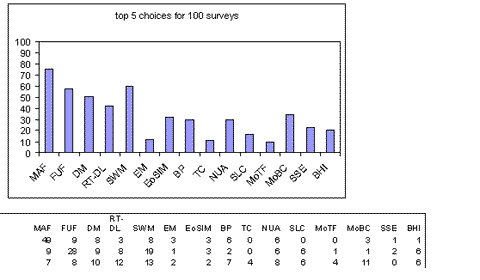
MAF–More Accurate Forecasts |
TC–Tertiary consumers (seabirds, whale, etc) |
FUF–Forecasts Updated Faster |
NUA–Nutrient Upwelling areas |
DM–Downloadable Maps |
SLC–Sea-level changes |
RTDL–RealTime Downloads |
MoTF–Maps of Through-Flows |
SWM–Surface Wind Maps |
MoBC–Maps of Boundary Currents |
EM–Eddy Maps |
SSE–Storm Surge Effects |
EoSI–Extent of Sea Ice Cover |
BHI–Benthic Habitat Information |
BP–Biological Productivity (primary productivity) |
***10 of the commercial fishermen surveys could not be used for numerical ranking, only top 5 choice selection.
Figure 1.
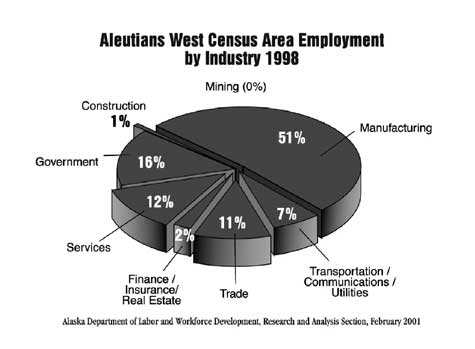
Dept. of Labor statistics for employment in the Aleutians West Borough.
Figure 2.
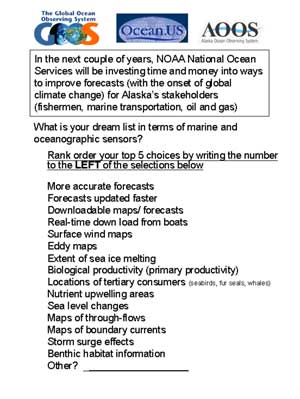
Survey Form.
Works Cited
Arendt, A.A., K.A. Echelmeyer, W.D. Harrison, C.S. Lingle, V.B. Valentine. 2002.
Rapid wastage of Alaska glaciers and their contribution to rising sea level. Science 297: 382-286.
Brass, G.W., Ed., 2002, Arctic Ocean Climate Change, US Arctic Research Commission Special Publication No. 02-1, Arlington, VA, 14p.
Global Warming: Early Warning Signs (http://www.climatehotmap.org/)
Humbolt squid seen in Alaska for the first time. Peace Scuba. (http://www.diver.net/bbs/messages/46107.shtml)
Kerr, R.A. 2002. A warmer Arctic means change for all. Polar Science 297 : 1490-1492.
Moritz, R.E., C.M. Bitz and E.J. Steig. 2002. Dynamics of Recent Climate change in the Arctic. Science 297 : 1497-1502.
Norcross, B. L., E.D. Brown, R.J. Foy, M. Frandsen, S.M. Gay, T.C. Kline, D.M. Mason, E.V. Patrick, A.J. Paul and K.D.E. Stokesbury. 2001. A synthesis of the life history and ecology of juvenile Pacific herring in Prince William Sound, Alaska. Fisheries Oceanography 10: 42-57.
Overland, J.E. and P.J. Stabeno. 2004. Is the climate of the Bering Sea warming and affecting the ecosystem? EOS 85(33): 309-316.
Sturm, M., D.K. Perovich and M.C. Serreze. October 2003. Meltdown in the North. Scientific American: 60-67.
U.S. Census Bureau. 2000. Geographic Area: Aleutians West Bourough (http://www.labor.state.ak.us/research/cgin/cenmaps/cas/aw.htm)
U.S. Census Bureau. 2000. Geographic Area: Unalaska City, Alaska. (http://www.labor.state.ak.us/research/cgin/cenmaps/cas/aw.htm)
Walther, G.R., E. Post, P. Convey, A. Menzel, C. Parmesan, R.J.C. Beebee, J.M. Fromentin, O. Hoegh-Guldberg and F. Bairlein. 2002. Ecological responses to recent climate change. Nature 416: 389-395.
Websites:
http://www.pfel.noaa.gov/research/climatemarine/cmffish/cmffishery.html#FISHPOPUL
http://www.ciel.org/Climate/Climate_Arctic.html
http://www.diver.net/bbs/messages/46107.shtml
This page is HTML
4.01 validated. Last modified
19-May-2005. Contact ASG web coordinator.